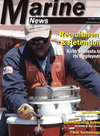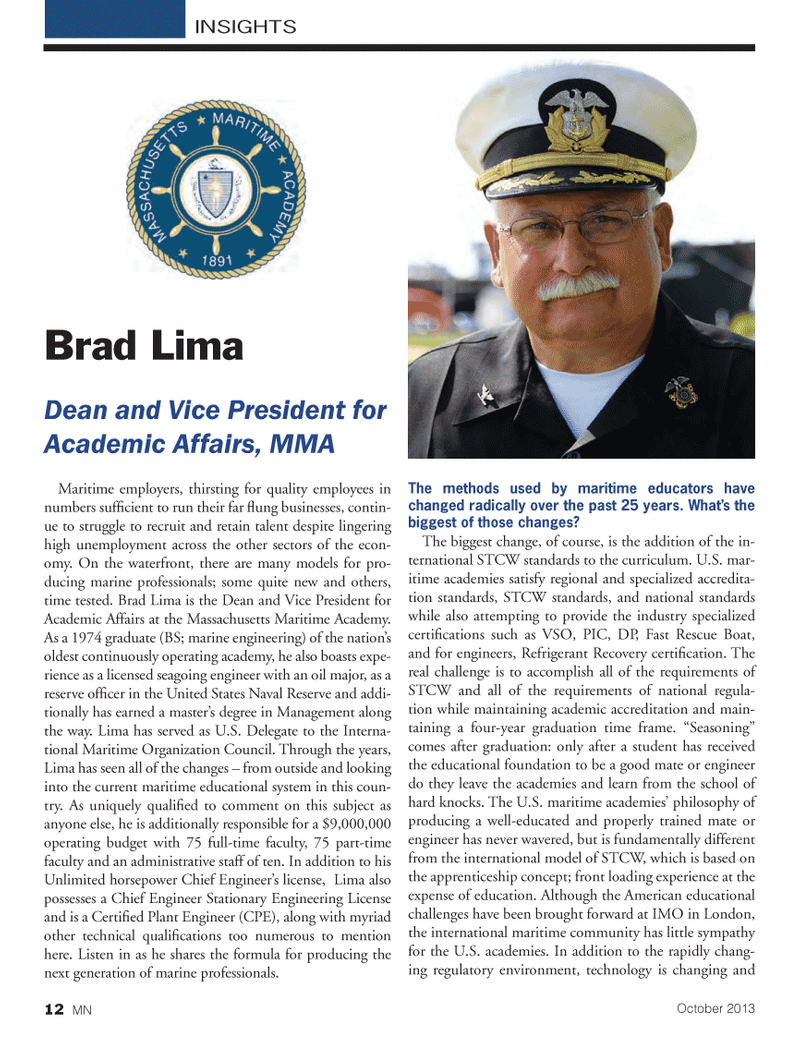
Page 12: of Marine News Magazine (October 2013)
Manning: Recruitment & Retention
Read this page in Pdf, Flash or Html5 edition of October 2013 Marine News Magazine
INSIGHTSMaritime employers, thirsting for quality employees in numbers sufÞ cient to run their far ß ung businesses, contin- ue to struggle to recruit and retain talent despite lingering high unemployment across the other sectors of the econ- omy. On the waterfront, there are many models for pro- ducing marine professionals; some quite new and others, time tested. Brad Lima is the Dean and Vice President for Academic Affairs at the Massachusetts Maritime Academy. As a 1974 graduate (BS; marine engineering) of the nationÕs oldest continuously operating academy, he also boasts expe- rience as a licensed seagoing engineer with an oil major, as a reserve ofÞ cer in the United States Naval Reserve and addi- tionally has earned a masterÕs degree in Management along the way. Lima has served as U.S. Delegate to the Interna- tional Maritime Organization Council. Through the years, Lima has seen all of the changes Ð from outside and looking into the current maritime educational system in this coun- try. As uniquely qualiÞ ed to comment on this subject as anyone else, he is additionally responsible for a $9,000,000 operating budget with 75 full-time faculty, 75 part-time faculty and an administrative staff of ten. In addition to his Unlimited horsepower Chief EngineerÕs license, Lima also possesses a Chief Engineer Stationary Engineering License and is a CertiÞ ed Plant Engineer (CPE), along with myriad other technical qualiÞ cations too numerous to mention here. Listen in as he shares the formula for producing the next generation of marine professionals. The methods used by maritime educators have changed radically over the past 25 years. What?s the biggest of those changes?The biggest change, of course, is the addition of the in-ternational STCW standards to the curriculum. U.S. mar- itime academies satisfy regional and specialized accredita- tion standards, STCW standards, and national standards while also attempting to provide the industry specialized certiÞ cations such as VSO, PIC, DP, Fast Rescue Boat, and for engineers, Refrigerant Recovery certiÞ cation. The real challenge is to accomplish all of the requirements of STCW and all of the requirements of national regula- tion while maintaining academic accreditation and main- taining a four-year graduation time frame. ÒSeasoningÓ comes after graduation: only after a student has received the educational foundation to be a good mate or engineer do they leave the academies and learn from the school of hard knocks. The U.S. maritime academiesÕ philosophy of producing a well-educated and properly trained mate or engineer has never wavered, but is fundamentally different from the international model of STCW, which is based on the apprenticeship concept; front loading experience at the expense of education. Although the American educational challenges have been brought forward at IMO in London, the international maritime community has little sympathy for the U.S. academies. In addition to the rapidly chang- ing regulatory environment, technology is changing and Brad LimaDean and Vice President for Academic Affairs, MMA October 201312 MNMN October2013 Layout 1-17.indd 12MN October2013 Layout 1-17.indd 1210/1/2013 9:59:16 AM10/1/2013 9:59:16 AM

 11
11

 13
13
